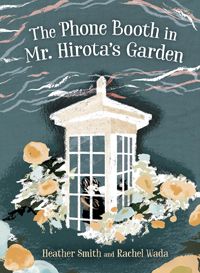Meeting Canadian Writers and Illustrators of Children’s Books
What inspires the writers of the books your students read? How does an illustrator decide what to draw? Is it true that most authors and illustrators don’t know each other? This column features a different Canadian children’s book creator in each issue and shows you the story beyond the covers.
 Heather Smith
Heather Smith
Her titles include beautiful books like Ebb & Flow, Bay Girl and now The Phonebooth in Mr. Hirota’s Garden. She is the winner of the 2019 TD Canadian Children’s Literature Award, shortlisted for the 2018 Governor General’s Literary Award, USBBY Outstanding International Book Selection 2019. Who is Heather Smith, prolific author of these books? Born in Newfoundland, she now calls Ontario home, where I contacted her and asked her some questions.
Margriet: As a child, you struggled with language. How did you become such a successful writer of children’s books?
Heather: As a child I hated words—I lacked the attention span to read them, had a speech impediment that made it difficult to speak them. Luckily, I made up for it in imagination. One of my favourite things was to “write” stories in my head. These stories were of high interest to me—no attention span needed! They were also uncomplicated by language rules I’d been taught in school but could never quite remember. This way of “writing” was freeing to me. My characters spoke the way people did in real life (with Newfoundland dialects). I could “write” these stories whenever I wanted—in the bath, in a car, during church. Never would I have dared to write these stories down. On paper, there would have been grammar and spelling mistakes! And what if someone asked me to read my story aloud? Why would I subject myself to the embarrassment of lisped Ss and mispronounced Rs? No, my stories belonged in my head. After all, I was an inarticulate kid who didn’t even read. What business did I have telling stories?
Fast forward to 2002. I have a son and a daughter. I still have stories in my head. This time, they are stories for children. This time, I want to write them down. So I do. I enjoy the process. I even step out of my comfort zone and submit a piece of my writing to the Kitchener Public Library for critique. Their Writer in Residence, Kathy Stinson, sees promise in my work. Encouraged, I sign up for Kathy’s workshops and write for older audiences. I’m told my work is honest and raw. What I had assumed was unsophisticated writing was actually worth sharing after all. Having the confidence to share my work helped me to grow as a writer. I’ve been honing my craft ever since.
Margriet: Did you love books as a child, or were they not a big part of your life then?
Heather: Our house was full of books. My parents and siblings were avid readers. But I found books boring. In schools today, I see teachers and teacher-librarians hand-selecting books for reluctant readers. I wish that had been my experience. A teacher saying, “Do I have the book for you!” could have made all the difference.
I did eventually come across books that stood out to me: Are You There God? It’s Me Margaret by Judy Blume and The Outsiders by S. E. Hinton. These contemporary, realistic books struck a chord with me and in later years were a source
of inspiration for my own writing.
Margriet: Fictional books are often partly biographical. Do your stories have seeds in your own life?
Heather: Snippets of my own life appear in my books, especially those set in Newfoundland. The setting, humour, the spirit of the characters are all drawn from my own experience.
In a way, I think all children’s writers create stories that are partly autobiographical. After all, we were once children. Our experiences in childhood—the good, the bad, and the ugly—help us to build realistic, relatable characters.
 Margriet: I love A Plan for Pops. Can you tell us more about that story?
Margriet: I love A Plan for Pops. Can you tell us more about that story?
Heather: I wanted to write a picture book that included, casually, a same-sex couple. I wanted one of the underlying themes to be “love is love”—not the same-sex relationship to be the focus of the book. Having the grandparents be Grandad and Pops as opposed to Grandma and Grandpa is inconsequential to the story. The story itself is about the grandparent/child relationship—which is a universal theme.
In this story, Pops ends up in a wheelchair. Struggling to cope with this new reality, Pops becomes withdrawn. Grandad tries to cheer Pop up but has little luck. That’s when Lou decides to take action. With skills learned from Grandad, Lou sets out to make a plan for Pops. I hope this story shows young readers that a combination of ingenuity and compassion can make a difference in the lives of others.
 Margriet: The Phone Booth in Mr. Hirota’s Garden is a powerful story sparked by a real event—the tsunami in Japan. Once you come across a great idea, how does it turn into a story in your mind?
Margriet: The Phone Booth in Mr. Hirota’s Garden is a powerful story sparked by a real event—the tsunami in Japan. Once you come across a great idea, how does it turn into a story in your mind?
Heather: As soon as I heard the NPR Podcast about Itaru Sasaki’s wind phone, I knew I wanted to write a children’s book inspired by his story. A simple object—a disconnected phone—helped a grieving community heal. It seemed a gentle, yet powerful, way to talk about death. To reach a young audience, it was important to create a child character through whom the story could be told. The story grew quickly in my mind and with the guidance and support of Orca Book Publishers, it bloomed. I am grateful to illustrator Rachel Wada for her stunning illustrations and also to have exchanged emails with Itaru Sasaki. With Rachel as translator, I shared my idea of fictionalizing his story. It was a thrill to receive his blessing and an honour to share his beautiful approach to grief through this book.
Margriet: What do you do during author presentations?
Heather: I talk about my past as a non-reader because there are many “mini-me’s” in the audience. I make it my job to assure these students that there are books out there for them—they just haven’t found them yet. Students are often surprised by my background as a non-reader. I talk about persevering despite perceived shortcomings and dealing with rejection. I especially love sharing titles that reflect the diversity of our country—stories that will be windows to some, mirrors to others; stories that have the power to open minds.
Margriet: How has writing books changed your life?
Heather: Writing is not just what I do, it’s who I am. Everything I see and do is done through a writer’s lens. My experiences seem to get filed inside my head somewhere, waiting to be drawn upon when I sit down to write. I know I am not alone in this. Writers are like sponges. We absorb everything around us, soaking in ideas that impact our writing.
For more information about Heather’s books, visit her website. heathertsmith.com
ABOUT THE AUTHOR
Margriet Ruurs
Margriet Ruurs is the author of 40 books for children. She also runs a booklovers’ B&B on a lavender farm on Salt Spring Island, BC. margrietruurs.com
This article is from Canadian Teacher Magazine’s Fall 2020 issue.












